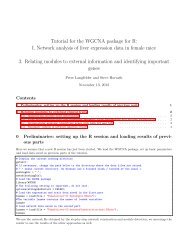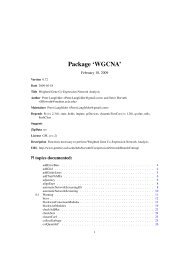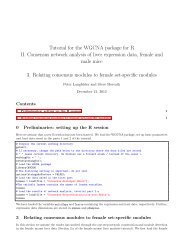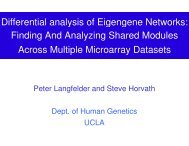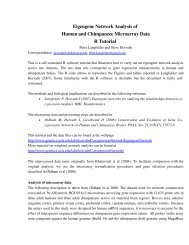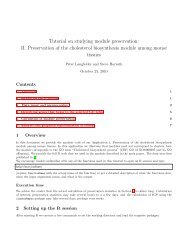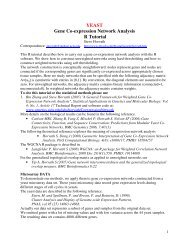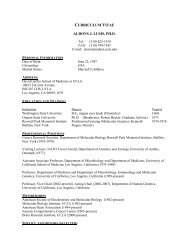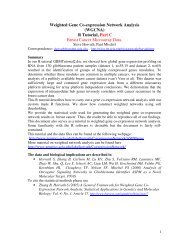Package 'WGCNA' - Laboratory Web Sites - UCLA
Package 'WGCNA' - Laboratory Web Sites - UCLA
Package 'WGCNA' - Laboratory Web Sites - UCLA
You also want an ePaper? Increase the reach of your titles
YUMPU automatically turns print PDFs into web optimized ePapers that Google loves.
22 blockwiseModules<br />
are smaller than those of the native module by the factor reassignThresholdPS, the gene is<br />
re-assigned to the closer module.<br />
In the last step, modules whose eigengenes are highly correlated are merged. This is achieved by<br />
clustering module eigengenes using the dissimilarity given by one minus their correlation, cutting<br />
the dendrogram at the height mergeCutHeight and merging all modules on each branch. The<br />
process is iterated until no modules are merged. See mergeCloseModules for more details on<br />
module merging.<br />
Value<br />
A list with the following components:<br />
colors a vector of color or numeric module labels for all genes.<br />
unmergedColors<br />
a vector of color or numeric module labels for all genes before module merging.<br />
MEs<br />
goodSamples<br />
goodGenes<br />
dendrograms<br />
TOMFiles<br />
blockGenes<br />
blocks<br />
blockOrder<br />
MEsOK<br />
a data frame containing module eigengenes of the found modules (given by<br />
colors).<br />
numeric vector giving indices of good samples, that is samples that do not have<br />
too many missing entries.<br />
numeric vector giving indices of good genes, that is genes that do not have too<br />
many missing entries.<br />
a list whose components conatain hierarchical clustering dendrograms of genes<br />
in each block.<br />
if saveTOMs==TRUE, a vector of character strings, one string per block, giving<br />
the file names of files (relative to current directory) in which blockwise topological<br />
overlaps were saved.<br />
a list whose components give the indices of genes in each block.<br />
if input blocks was given, its copy; otherwise a vector of length equal number<br />
of genes giving the block label for each gene. Note that block labels are not<br />
necessarilly sorted in the order in which the blocks were processed (since we do<br />
not require this for the input blocks). See blockOrder below.<br />
a vector giving the order in which blocks were processed and in which blockGenes<br />
above is returned. For example, blockOrder[1] contains the label of the<br />
first-processed block.<br />
logical indicating whether the module eigengenes were calculated without errors.<br />
Note<br />
If the input dataset has a large number of genes, consider carefully the maxBlockSize as it significantly<br />
affects the memory footprint (and whether the function will fail with a memory allocation<br />
error). From a theoretical point of view it is advantageous to use blocks as large as possible; on the<br />
other hand, using smaller blocks is substantially faster and often the only way to work with large<br />
numbers of genes. As a rough guide, it is unlikely a standard desktop computer with 4GB memory<br />
or less will be able to work with blocks larger than 8000 genes.<br />
Author(s)<br />
Peter Langfelder



